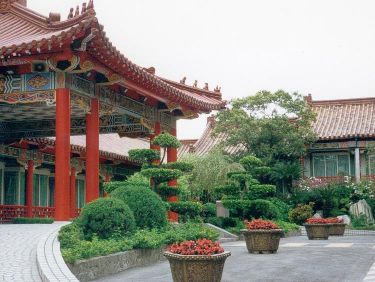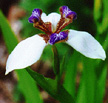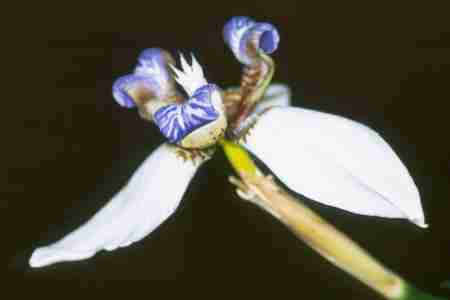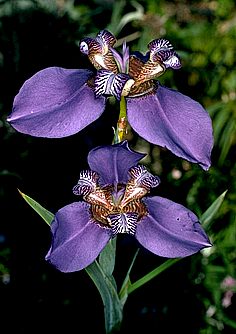(text only version)
An Apostle without Honor in its own Land
By Clement Kent
Some alert readers will have already noted that the phrase above is not quite
right. Neither was my plant identification - and therein hangs a story.
I canít quite remember (ah! The ravages of age) whether I ever wrote for
the Hort about my Taiwan Iris. I might well have done, for it was an exciting
plant acquisition for me at the time. On the other hand, I might well not
have done, since I was rather busily flying back and forth to Taipei at the
time.

To recap (in the one case) or to introduce you (in the other), put yourself
in my position. I was taking a much deserved rest from rather vigorous computer
software activity, by spending a weekend in the Grand Hotel in Taipei. It was
a rather grand sort of place, in a peculiar half-built, half destroyed way. It
towered above a major interchange near downtown Taipei, with a tall tower whose
steel girder roof was shaped in traditional Chinese temple style, but which
unaccountably lacked any covering over the girders. My Taiwanese coworkers
explained to me that the hotel was owned by the Federal Government. During
renovations the roof and top floor had caught fire, and the Feds were somewhat
dilatory about finding the cash to fix it. However, while the top of the tower
awaited its eventual renovation, the old part of the hotel continued operations,
and that is where I stayed.
Located in a singularly auspicious location on a hillside overlooking a
river, with metropolitan Taipei on the other side, the Grandís view is, well,
grand! The hotel was originally built as a showpiece project to encourage
tourism and business visitors during the difficult and tension-filled years of
the 50ís, and highlighted the work of many skilled craftspeople who had
accompanied the Nationalist government of Chiang Kai-Shek into exile. As a
result of government funding and the presence of numerous masters of traditional
Chinese woodworking and design, the old building is a striking example of
Chinese styles. The rooms in the old wing are large and airy, with great carved
chairs, desks, and bureaus. Each looks out onto a balcony whose posts, railings,
and roof are liberally decorated with carvings and gaily painted in bright
colors.

I believe I wrote before of the temple on the hill above the Hotel, with its
100 plants in pots on its terrace and its vegetable garden for the monks. All
around the temple are other smaller temples and social clubs, reachable only by
small, winding paths that ascend or descend steeply. And lining these paths in
many locations were plants that were unmistakably of the iris family. I watched
eagerly for their flowers, but it wasnít until my last visit to Taiwan in
April of one year that I saw them in bloom, and then I had the misfortune to
discover them at a time when I had only half an hour left to descend the hill,
pack my bags, and catch a cab. You can understand that my inspection of the
fragrant white flowers was cursory.
During all my visits to Taiwan I had been looking for irises, especially the
roof iris, Iris tectorum.
Taiwan was occupied by the Japanese for many years prior to 1945, and this
small, beardless iris with beautiful white or blue flowers was traditionally
planted in the thatch on the roofs of old cottages and temples in Japan. I also
knew from books of a related beardless iris species, Iris formosanum,
which is endemic to the island of Formosa, a.k.a. Taiwan. Indeed, early one
March during one of the torrential thunderstorms which traditionally start off
spring in Taiwan, I suddenly, soddenly found I. tectorum growing around
an old Buddhist temple on a mountainside 100 kms southeast of Taipei. But it was
short, unlike the almost 2 foot tall leaves of the clumps on the hillside above
the Grand.
One peculiarity of the "Grand" iris was that many smaller clumps
could be found loose on the paths. I attributed this at first to simple erosion,
until I noticed in a reference book that I. formosanum could spread by
runners, forming clumps. I immediately became convinced that in a burst of
Nationalistic pride, the locals had planted their own national iris all over the
hillsides of the mountain.
We will draw a veil over the somewhat unorthodox methods by which I acquired
my clump of the "Grand" iris, other than to say some smelly socks were
involved. In Toronto, it was potted up and very carefully treated just as
advised by a correspondent to the journal of the Species Iris Group of North
America: constantly moist without ever letting it stand in stagnant water, a
fair bit of light without burning noonday sun, etc. The clump grew vigorously in
our kitchen window, perhaps the only place in our house warm and light and humid
enough for it (itís right above the sink). Years went by with no trace of
bloom, however.
Finally, last year I saw buds rising up within the leaf fans. Have you ever
watched for this in your garden irises? Thereís no sign at all of buds, until
you notice a peculiar thickening in the middle of the fan of leaves. It swells
surreptitiously for what seems like a very long time, and at last the bloom
stalk pops out. There should be a little "ta da!" trumpet flourish
when this finally happens. The "Grand" iris did this last March. The
waiting and anticipation were even more excruciating than in the garden. Up, and
up, and up went the bloom stalk, until an entire not-too-attractive scaffolding
of chopsticks and bamboo stakes was deployed to keep it from toppling. Yours
truly brooded over it like a mother hen, for even a dayís drying out in bright
spring sun could blast the developing flower buds. Finalement the slender
white bud emerged, and opened into a small (2 inches wide) flower with 3
glistening white horizontal petals with central yellow barring shading into
brown, and 3 very odd, squashed-looking blue standards standing up above the
petals. The scent was the heavenly fragrance of the best of the iris family.
At
 the end of the day the flower closed forever and I felt quite let down.
Being sloppy, I didnít pick off the withering bloom, but passed on to other
things. Bless sloppiness! Over the next 3-4 weeks that "withering
bloom" put out new flowers every so often, the longest period Iíve ever
seen any iris bloom stalk last. The buds were hidden down inside a covering,
instead of being spaced out visibly on the stem as in the bearded irises.
Simultaneously, three other bloom stalks rose out of other leaf fans, until
hardly a day went by without a sweet smelling flower or two over the drying
breakfast dishes.
the end of the day the flower closed forever and I felt quite let down.
Being sloppy, I didnít pick off the withering bloom, but passed on to other
things. Bless sloppiness! Over the next 3-4 weeks that "withering
bloom" put out new flowers every so often, the longest period Iíve ever
seen any iris bloom stalk last. The buds were hidden down inside a covering,
instead of being spaced out visibly on the stem as in the bearded irises.
Simultaneously, three other bloom stalks rose out of other leaf fans, until
hardly a day went by without a sweet smelling flower or two over the drying
breakfast dishes.
You can understand that by then, nothing on earth would persuade me to do my
duty and prune off the finished bloom stalk to conserve energy for next yearís
flowering. I kept expecting, right up until June, to see just one more little
bud peeping out. Instead, what I saw was leaves emerging from the bud
covering! At first I thought I was mistaken, but soon it was unmistakable: four
new baby plants were growing, one at the end of each long, floppy flower
"stalk" (which actually was a long skinny leaf). At last I understood
why I saw so many "orphan" clumps on the mountainside paths: they were
babies detached from the mother plant.
Orchid growers know of this growth habit: itís the easiest way to propagate
some sorts of tropical orchids. They call them keikis, a word which I
believe to be of Japanese origin (can any readers confirm this?). Of course, we
all know of keikis in Mexican Hat Plants. Perhaps you may have seen our
native Walking Fern (Camptosorus rhizophyllus) on the Bruce Trail spread
its long, thin fronds over the shady, mossy side of a limestone boulder, then
root and sprout again at the tip. Recently in a Costa Rican cloud forest I saw 6
foot tall ferns with the same "babies on the leaf tip" habit. Finally
this winter I got around to cutting off the iris keikis and planting them
in their own pots. I shall put one or two into the Hort spring sale; by then
their roots should be well established.
Christmas í98 came; the keikis were rooting and off we went to
Grandmaís house. There, during one of those lulls in the greet-and-eat
festivities, I idly pulled out an old Time-Life Gardening volume on flowering
houseplants and flipped through the illustrations. My daughter had asked for
some house plants of her own and I wanted to refresh my memory of which ones
would be indestructible and pretty too. Egads! There it was! The "Grand
iris" was an imposter!!

It appears that instead of coddling an exotic asian I. formosanum, I
had been growing the Central American "Apostle plant". The Apostle was
without honor in its own land.
Neomarica gracilis is indeed in the iris family, but itís not an
iris. Known as Apostle plant, Walking iris, Twelve Apostle, Toad-Cup Lily, and
False Flag, it can be found from southern Mexico to Brazil.
N. Northiana
and N. caerulea from Brazil have flowers up to 4 inches across with the
same strong fragrance. Northiana apparently looks quite a bit like gracilis,
but caerulea rather logically has blue outer petals. Does any Hort member
have either of these two theyíd like to trade? Let me know!
If you have a suitable bright kitchen or bathroom window, Apostle plant is
highly recommended. The only pest Iíve seen bother it was scale insects. It
was very easy to eliminate these by the traditional method of wiping the leaves
with alcohol. The leaves are ornamental, and the bloom season is long at a time
when we really appreciate flowers. Our first bloom this year was open February
23, and it looks like weíll have 5 or 6 bloom stalks. A fantastic plant,
really, if only I could get the name right!
Copyright 2001 by Clement Kent, c l e m e n t @ g o d e l . n e t
Articles
 the end of the day the flower closed forever and I felt quite let down.
Being sloppy, I didnít pick off the withering bloom, but passed on to other
things. Bless sloppiness! Over the next 3-4 weeks that "withering
bloom" put out new flowers every so often, the longest period Iíve ever
seen any iris bloom stalk last. The buds were hidden down inside a covering,
instead of being spaced out visibly on the stem as in the bearded irises.
Simultaneously, three other bloom stalks rose out of other leaf fans, until
hardly a day went by without a sweet smelling flower or two over the drying
breakfast dishes.
the end of the day the flower closed forever and I felt quite let down.
Being sloppy, I didnít pick off the withering bloom, but passed on to other
things. Bless sloppiness! Over the next 3-4 weeks that "withering
bloom" put out new flowers every so often, the longest period Iíve ever
seen any iris bloom stalk last. The buds were hidden down inside a covering,
instead of being spaced out visibly on the stem as in the bearded irises.
Simultaneously, three other bloom stalks rose out of other leaf fans, until
hardly a day went by without a sweet smelling flower or two over the drying
breakfast dishes.

